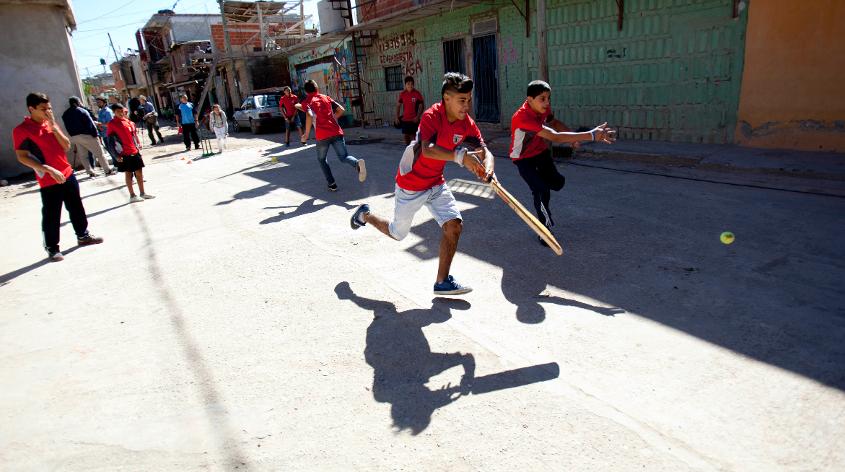As a general rule of thumb, if you’re going to talk up a strategy for Global Growth, it’s probably better to come with rather more than a couple of glossy sheets, largely composed of empty platitudes.
And it would certainly be better not to promise to ‘deliver competitive cricket with context for all Members’ barely four days after you’ve abolished a competition which did exactly that in favour of pointless bilateral ODI series for the privileged few and reliance on a discredited and blatantly corruptible rankings system.
You could almost feel sorry for ICC chair Greg Barclay and his brand-new CEO Geoff Allardice, sent out to spruik this so-called ‘strategy’, which offers even less than the ICC’s Seven Pillars a decade ago, most of which never got implemented.
Sometimes it seems that every newly-appointed ICC official must be issued with a pair of shoes pre-painted with targets on them, so they can shoot themselves in the foot more accurately.

To be fair, there are some positive features to this ‘Framework’: the strong emphasis on women’s cricket is welcome, and the commitment to expand all ICC events, while scarcely new, does deserve constant repetition until it’s actually implemented, and implemented without the smoke-and-mirrors chicanery of the current T20 World Cup format.
But for the rest, it’s so vague as to be positively insulting.
So it’s now the ICC’s goal to strengthen the game by proposing to ‘build cricket among Associate members’? Really? Was that not the goal of the Global Development Program twenty years ago, until it was decimated by the greed of the Gang of Three (the BCCI, the ECB and Cricket Australia, in case you’ve forgotten)? And hasn’t it been, on paper at least, a goal all along?
What does it actually mean, in this Brave New World of the strategy for Global Growth? And please don’t tell me that it means to ‘bring about transformative growth in participation, with more people playing cricket by 2032’, because until you show me how you’re going to achieve that, and where the money’s going to come from to achieve it, you’re doing no more than serve up another word salad designed to absolve you from actually doing anything meaningful.
Then there’s the plan, if it can be called a plan, to ‘build digital platforms that enable Members to create direct relationships with 300 million fans by 2032’, elsewhere described, in very small print, as ‘digital transformation to attract and engage fans, diversify revenue streams’.
Ah, revenue streams! Could they be the key to this drive for fan engagement, 300 million of them over the next decade, with or without the 250 million incremental fans – have you ever met an incremental fan? – of the women’s game and the 50 million new fans in the USA ‘through investment in growth markets’?
It is doubtless very significant that the only numbers in this document, and the only mention of investment, come in relation, not to growing the game itself, but to expanding its fan base.

Because ultimately the ICC no longer has much to do with governing the game and everything to do with using it as an instrument for making money, which it can channel into the coffers of its most powerful members.
Let’s try to imagine what this document might say to turn it into something worth believing in.
In the first place, it could commit the ICC to returning the its budget allocations for the Associate Members and development to where they were before the putsch by the Gang of Three, because unless that’s done all this talk of growing the game in the 94 Associates is nothing more than a cruel hoax.
Then it might offer some concrete programmes to turn that worthy, indeed essential, ambition into reality. That could include reinstating the system of regional tournaments, especially for younger players of both sexes, and returning the Regional Offices to a level where they are actually capable of making a difference on the ground.
It could include some real commitment to levelling up playing standards across all formats, T20, 50-over and multi-day, by ensuring meaningful competitions between major events and a requirement that countries at every level get regular opportunities to meet opponents currently a bit stronger than they are.
This would certainly involve retention of the Super League, and re-instituting – and properly funding – the greatly-missed Intercontinental Cup.
And such a practical framework should certainly include financial incentives for members who reached out beyond their existing constituencies, which in many places consist largely of expatriate and immigrant communities, to bring the game to members of their host societies. No-one pretends that’s easy, but if cricket is to become truly global, it has to be a key element in its growth.
I’m not as sceptical about the ICC’s vaunted criiio programme as many people I know, but to make it truly effective it needs lots of investment of time, energy, imagination and ultimately money to help local volunteers adapt it to local conditions.
In the end, it all comes back to money, money for investment in the game. Until the ICC understands that, we will continue to be confronted with these back-of-the envelope exercises in management speak which merely confirm its utter unfitness for purpose as cricket’s governing body.
You’re reading Emerging Cricket — brought to you by a passionate group of volunteers with a vision for cricket to be a truly global sport, and a mission to inspire passion to grow the game.
Be sure to check out our homepage for all the latest news, please subscribe for regular updates, and follow EC on Twitter, Facebook, LinkedIn and YouTube.
Don’t know where to start? Check out our features list, country profiles, and subscribe to our podcast.
Support us from US$2 a month — and get exclusive benefits, by becoming an EC Patron.







